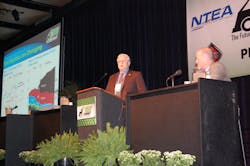Fleets eyeing more alternative acquisitions
INDIANAPOLIS. A long awaited “restocking” of the commercial vehicle population is expected to continue at a slow yet steady pace through 2016, according to data tracked by the National Truck Equipment Assn.(NTEA). However, more and more of the new vehicles added to the fleet population – especially in the Class 3-8 segments – are expected to be powered by a range of alternative fuels, the group noted.
“We don’t have a lot of empirical data yet, but we’re seeing some interesting trends for green trucks developing,” said Doyle Sumrall, NTEA’s senior director of business development, during a speech (pictured) here at the group’s 2012 convention.
“The number of trucks powered by natural gas and propane are expanding nicely, and we project a greater increase in their numbers in 2013,” he noted. “Hybrid truck sales, by contrast, are a little off but there’s still high interest out there. Those trends are heartening but [alternative fuels] remain a complex issue as there’s a need to work more closely to optimize equipment for particular operations.”
Sumrall said as of this year, the overall population of commercial Class 3-8 trucks is down by about 500,000 units largely as fleets are removing older equipment from service. According to NTEA surveys, interest is not only high now for new trucks but also ones powered by alternative fuels, versus a more concentrated focus on the used truck market over the past few years.
“The major trends we see developing now are government and industry aligning themselves more as partners; green strategies, including but not limited to using alternative fuels, becoming more mainstream; and a greater focus on lifecycle cost, as achieving payback for new vehicle investment is now the critical part,” Sumrall noted.
In terms of green strategies, he noted that fleets surveyed by NTEA are investing in oil analysis programs, replacing air with nitrogen in tires to make them last longer, while moving to smaller engines and chassis.
“While there’s a lot more interest and demand for natural gas powered trucks, we’re seeing fleets taking more broad-based efforts to boost fuel efficiency and [vehicle] productivity,” Sumrall said. “Overwhelmingly, lifecycle costs advantages are going to push all of this forward.”
About the Author
Sean Kilcarr
Editor in Chief
Sean Kilcarr is a former longtime FleetOwner senior editor who wrote for the publication from 2000 to 2018. He served as editor-in-chief from 2017 to 2018.
